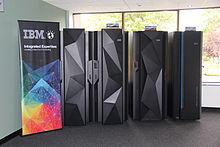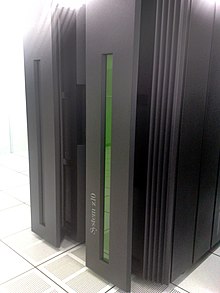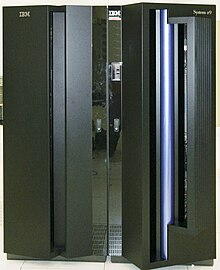IBM Z
| History of IBM mainframes, 1952–present |
|---|
| Market name |
| Architecture |


IBM System z (officially "IBM z Systems")[1] is a family name used by IBM for all of its mainframe computers. In 2000, IBM renamed the existing System/390 to IBM eServer zSeries with the e depicted in IBM's red trademarked symbol, but because no specific machine names were changed for System/390, the zSeries in common use refers only to the z900 and z990 generations of mainframes. In April 2006, with another generation of products, the official family was changed to IBM System z, which now includes both older IBM eServer zSeries, the IBM System z9 models, the IBM System z10 models, and the newer IBM zEnterprise.[2] The zSeries, System z and zEnterprise families were named for their availability – z stands for zero downtime. The systems are built with spare components capable of hot failovers to ensure continuous operations.[3] The System z family maintains full backward compatibility. In effect, current systems are the direct, lineal descendants of System/360, announced in 1964, and the System/370 from the 1970s. Many applications written for these systems can still run unmodified on the newest System z over five decades later.[4]
IBM System z13
This section contains content that is written like an advertisement. (August 2015) |
- First system able to process 2.5 billion transactions per day
- IBM's first mainframe capable of real-time encrypting all transactions at scale
- First mainframe system with embedded analytics providing real-time transaction insights[5]
IBM zEnterprise System
The IBM zEnterprise System (zEnterprise), announced in July 2010, with the z196 model, is designed to offer both mainframe and distributed server technologies in an integrated system. The zEnterprise System consists of three components.[6] First is a System z server. Second is the IBM zEnterprise BladeCenter Extension (zBX). Last is the management layer, IBM zEnterprise Unified Resource Manager (zManager), which provides a single management view of zEnterprise resources. The zEnterprise is designed to extend mainframe capabilities – management efficiency, dynamic resource allocation, serviceability – to other systems and workloads running on AIX on POWER7, and Microsoft Windows or Linux on x86.[7]
The zEnterprise BladeCenter Extension (zBX) is an infrastructure component that hosts both general purpose blade servers and appliance-like workload optimizers which can all be managed as if they were a single mainframe. The zBX supports a private high speed internal network that connects it to the central processing complex, which reduces the need for networking hardware and provides inherently high security.
The IBM zEnterprise Unified Resource Manager integrates the System z and zBX resources as a single virtualized system and provides unified and integrated management across the zEnterprise System. It can identify system bottlenecks or failures among disparate systems and if a failure occurs it can dynamically reallocate system resources to prevent or reduce application problems. The Unified Resource Manager provides energy monitoring and management, resource management, increased security, virtual networking, and information management from a single user interface.
Highlights of the original zEnterprise z196 include:
- BladeCenter Extension (zBX) and Unified Resource Manager
- Up to 80 central processors (CPs)
- 60% higher capacity than the z10 (up to 52,000 MIPS)
- Twice the memory capacity
- 5.2 GHz quad-core chips
The newest zEnterprise, the EC12, was announced in August 2012, and included:
- Up to 101 central processors (CPs)
- 50% higher capacity than the z196 (up to 78,000 MIPS)
- Transactional Execution
- 5.5 GHz hex-core chips
- Flash Express – integrated SSDs which improve paging and certain other I/O performance
On April 8, 2014, in honor of the 50th anniversary of the System/360 mainframe, IBM announced[8] the release of its first converged infrastructure solution based on mainframe technology. Dubbed the IBM Enterprise Cloud System,[9] this new offering combines IBM mainframe hardware, software, and storage into a single system and is designed to compete with competitive offerings from VCE, HP, and Oracle. According to IBM, it is the most scalable Linux server available with support for up to 6,000[10] virtual machines in a single-footprint.
In June 2014, IBM announced[11] it had shipped its first Enterprise Cloud System to Vissensa, a UK-based managed service provider.
IBM System z10

The IBM System z10 servers support more memory than previous generation systems and can have up to 64 central processors (CPs) per frame. The full speed z10 processor's uniprocessor performance is up to 62% faster than that of the z9 server, according to IBM's z10 announcement. New capabilities for System z10 servers:
- 50% more performance and 70% more usable capacity. The new 4.4 GHz processor was designed to address CPU intensive workloads and support large scale server consolidation on the mainframe.
- Just-in-time capacity and management – monitoring of multiple systems based on Capacity Provisioning and Workload Manager (WLM) definitions. When the defined conditions are met, z/OS can suggest capacity changes for manual activation from a z/OS console, or the system can add or remove temporary capacity automatically and without operator intervention.[12]
IBM System z9

In July 2005, IBM announced a new family of servers – the System z9 family – with the IBM System z9 Enterprise Class (z9 EC) and the IBM System z9 Business Class (z9 BC) servers. The System z9 servers offered:
- More flexibility on the enterprise class servers in customizing and sizing the capacity of the general purposes processors (CPs) that reside in the server. The z9 EC servers offered four different sub-capacity settings when run with eight or fewer general purpose processors.
- zIIP engines. The zIIP is designed so that a program can work with z/OS to have all or a portion of its Service Request Block (SRB) dispatched work directed to the zIIP to help free up capacity on the general purpose processor which may make it available for use by other workloads running on the server.
- MIDAW. The Modified Indirect Data Address Word (MIDAW) facility offers an alternative facility for a channel program to be constructed. It is designed to improve performance for native FICON applications that use extended format datasets (including DB2 and VSAM) by helping to improve channel utilization, reduce channel overhead, and improve I/O response times.
- CP Assist for Cryptographic Functions (CPACF) is shipped on every CP and IFL processor in support of clear key encryption. CPACF was enhanced for System z9 processors to include support of the Advanced Encryption Standard (AES) for 128-bit keys, Secure Hash Algorithm-256 (SHA-256), CPACF offers DES, Triple DES and SHA-1.
IBM zSeries family

The zSeries family, which includes the z900, z800, z990 and z890, introduced IBM's newly designed 64-bit z/Architecture to the mainframe world. The new servers provide more than four times the performance of previous models. In its 64-bit mode the new CPU is freed from the 31-bit addressing constraints of its predecessors. Major features of the eServer zSeries family:
- Based on z/Architecture (64-bit real and virtual addressss), as opposed to earlier ESA/390 (31-bit) used in S/390 systems yet emphasizing the backwards compatibility the ESA/390 applications are fully compatible with z/Architecture
- First zSeries Superscalar server (z990) – A superscalar processor allows concurrent execution of instructions by adding additional resources onto the microprocessor to achieve more parallelism by creating multiple pipelines, each working on its own set of instructions.
- Offers up to 32 central processors (CPs) per frame
- Frames can be coupled in up to a 32-frame Sysplex, with each frame physically separated up to 100 kilometers
- Supports the z/OS, Linux on System z, z/VM, z/VSE, and z/TPF operating systems
- Support of multiple I/O channel subsystem – or multiple Logical Channel Subsystem (LCSS). The z990 allows for support of up to four LCSS – offering support for up to 4 times the previous 256 channel limit
- Support for zAAP processors. These specialty processors allow IBM JVM processing cycles to be executed on the configured zAAPs with no anticipated modifications to the Java application(s). This means that deployment and integration of new Java technology-based workloads can happen on the very same platform as heritage applications and core business databases in a highly cost-effective manner
Comparison to other servers
This section contains content that is written like an advertisement. (May 2015) |
A direct comparison of System z servers with other computing platforms is difficult. For example, System z servers offload such functions as I/O processing, cryptography, memory control, and various service functions (such as hardware configuration management and error logging) to dedicated processors. These "extra" processors are in addition to the (up to) 141 cores per frame.[13] System z cores include extensive self checking of results, and if an error is detected the server retries the instruction. If the instruction still fails, the server shuts down the failing processor and shifts workload, "in flight," to a surviving spare processor. The IBM mainframe then "calls home" (automatically places a service call to IBM). An IBM service technician replaces the failed component with a replacement part (possibly even a new processor book, consisting of a group of processors). With System z9 servers, the technician installs the new book and removes the old one without interruption to running applications. (Note that mainframes have reported MTBF figures of 20–50 years).[14] Similar design redundancies exist in memory, I/O, power, cooling, and other subsystems. All these features exist at the hardware and microcode level, without special application programming. The same concepts can extend to coupled frames separated by up to 100 kilometers in a Geographically Dispersed Parallel Sysplex when z/OS is used. System z servers are used by IBM customers for business-critical installations in medium and large organizations which need very high availability, where scheduled and unscheduled downtime costs are high, and at traditional "mainframe shops" such as banks and insurance companies which already have mainframe applications at the center of their business processes. For such organizations which have to consider a very high price for system failures and service outages, System z machines may provide a lower total cost of ownership than other platforms, especially when running a variety of business-critical applications concurrently (so-called mixed workload). Overall, mainframes like System z are used in government, financial services, retail, manufacturing, and just about every other industry.
List of models (reverse chronological order)
zEnterprise System/z Systems mainframe:
- z Systems z13 (2964 series), introduced on January 13, 2015[15]
- zEnterprise BC12 (2828 machine type), introduced on July 23, 2013
- zEnterprise EC12 (2827 series), introduced on August 28, 2012
- zEnterprise 114 (2818 series), introduced on July 6, 2011
- zEnterprise 196 (2817 series), introduced on July 22, 2010
System z10 mainframe:
- z10 Business Class (2098 series), introduced on October 21, 2008
- z10 Enterprise Class (2097 series), introduced on February 26, 2008
System z9 mainframes:
- z9 Business Class (2096 series), successor to the z890 and smallest z990 models (2006)
- z9 Enterprise Class (2094 series), introduced in 2005, initially as z9-109, beginning the new System z9 line
zSeries mainframes:
- z890 (2086 series), successor to the z800 and smaller z900 models (2004)
- z990 (2084 series), successor to larger z900 models (2003)
- z800 (2066 series), entry-level, less powerful variant of the z900 (2002)
- z900 (2064 series), for larger customers (2000)
Older S/390 IBM mainframe servers are not listed here since support for the last S/390 compatible version of z/OS (1.5) was dropped on March 31, 2007.[16]
See also
- List of IBM products
- Linux on System z
- zAAP
- zIIP
- Peer to Peer Remote Copy
- Extended Remote Copy
- LPAR
- HiperSocket
- ESCON
- FICON
- IBM Parallel Sysplex
- Hercules emulator
- z/VM
- z/OS
- OpenSolaris for System z
- Gameframe
References
- ^ IBM Corporation, IBM Mainframes - z Systems, retrieved 2015-04-20
- ^ IBM Corporation, IBM System z9 Enterprise Class Update (formerly System z9 109) Frequently Asked Questions (PDF), retrieved 2007-10-23
- ^ Selecting System z operating environments: Linux or z/OS?
- ^ "Mainframe strength: Continuing compatibility". z/OS basic skills information center. IBM. Retrieved 12 October 2012.
- ^ http://www-03.ibm.com/press/us/en/pressrelease/45808.wss
- ^ "Introducing the zEnterprise System". IBM zEnterprise System Technical Introduction. IBM. Retrieved 2 October 2012.
- ^ "IBM's mainframe-blade hybrid to do Windows". The Register. Retrieved 12 October 2012.
- ^ "IBM Brings New Cloud Offerings, Research Projects and Pricing Plans to the Mainframe". IBM News Room. IBM. 8 April 2014. Retrieved 2014-07-18.
- ^ "IBM Enterprise Cloud System". IBM System z: Enterprise Cloud System. IBM. 8 April 2014. Retrieved 2014-07-18.
- ^ "IBM Brings New Cloud Offerings, Research Projects and Pricing Plans to the Mainframe". Enterprise Systems Media. 10 April 2014. Retrieved 2014-07-18.
- ^ Taft, Darryl (2014-06-27). "IBM Ships Its First Enterprise Cloud System to Vissensa". eWeek. Retrieved 2014-07-18.
- ^ "System functions and features". IBM System z10 Business Class Technical Overview. IBM.
- ^ IBM. "The IBM z13". The IBM z13. IBM. Retrieved 20 April 2015.
- ^ "Mainframes in Perspective: The Slumbering Dinosaur Awakes" (PDF). Atos Origin. Retrieved 12 October 2012.
- ^ IBM. "IBM Launches z13 Mainframe". IBM. IBM. Retrieved 20 April 2015.
- ^ End of Support for z/OS 1.4 and z/OS 1.5 is Approaching
External links
- IBM Destination z
- IBM Systems Mainframe Magazine
- IBM System z web page
- Z6 microprocessor The follow-on to Z9, by Charles F. Webb of IBM
- IBM Archives: A Brief History of the IBM ES/9000, System/390 AND zSeries
